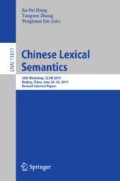Abstract
By investigating the frequency distribution of 37 verbs in Mandarin ditransitive constructions and adopting a collostructional analysis (cf. Gries & Stefanowitsch [1]), this study aims to clarify the construction meaning of each type of ditransitive construction. The preliminary result shows that two constructions differ in terms of fine-grained aspects, such as the number and completion of transfer events. Based on the corpus findings, this study claims that the transfer meaning expressed by double-object constructions entails only one entire macro-event while the transfer event expressed by prepositional dative constructions highlights and involves more than one event, thus increasing the possibility of the prepositional dative conveying incomplete transfer meaning.
Access this chapter
Tax calculation will be finalised at checkout
Purchases are for personal use only
Notes
- 1.
In this paper, we use the term “ditransitive construction” (in contrast with Liu’s [6] term of “dative construction”) to sum up all types of Mandarin double-object sentences. In addition, we classify the prototype of double-object ([V NP1 NP2]) and [V gei NP1 NP2] as the same category of “double-object construction” while the sentences that consist of preposition are classified into “prepositional dative construction”.
- 2.
Based on the definition of ditransitive construction (see footnote 1), the term dative alternation in this paper is used to refer to the alternation between DO (double-object construction (including prototype of double-object [V NP1 NP2] and V-gei complex [V gei NP1 NP2]) and PD (prepositional dative construction).
- 3.
This paper attempts to identify the construction meaning of two types of double-object construction based on the meanings of their representative verbs. Therefore, whether gei in [V NP2 gei NP1] is a preposition or a verb will not actually affect the analysis result.
References
Gries, St. Th.: Extending collostructional analysis: a corpus-based perspective on ‘alternations’. Int. J. Corpus Linguist. 9(1), 97–129 (2004)
Tyler, A.: Cognitive Linguistics and Second Language Learning. Routledge, New York (2012)
Goldberg, A.: Constructions: A Construction Grammar Approach to Argument Structure. Chicago University Press, Chicago (1995)
Gries, St.Th., Hampe, B., Schönefeld, D.: Converging evidence II: more on the association of verbs and constructions. In: Rice, S., Newman, J. (eds.) Empirical and Experimental Methods in Cognitive/Functional Research, pp. 59–90. CSLI Publications, Stanford (2010)
Haspelmath, M.: Ditransitive constructions. Annu. Rev. Linguist. 1, 19–41 (2015)
Liu, F.: Dative constructions in Chinese. Lang. Linguist. 7(4), 863–904 (2006)
Huang, C., Ahrens, K.: The function and category of GEI in Mandarin ditransitive constructions. J. Chin. Linguist. 27(2), 1–26 (1999)
Liu, Danqing: A typological study of giving-type ditransitive patterns in Chinese. Zhongguo Yuwen 5, 387–397 (2001)
Colleman, T., Bernolet, S.: Alternation biases in corpora vs. picture description experiments: DO-biased and PD-biased verbs in the Dutch dative alternation. In: Divjak, D., Gries, St.Th. (eds.) Frequency Effects in Language Representation, pp. 87–126. De Gruyter Mouton, Berlin/Boston (2012)
Gu, Mingdi: Internal inheritance research on Chinese ditransitive. Chin. Lang. Learn. 6, 45–51 (2014)
Lin, Y.: Analysis of the double-subject construction’s event structure and it’s requirement of syntactic representation. Wuhan Univ. Technol. 28(4), 679–773 (2015)
Goldberg, A.E.: Verbs, constructions, and semantics frame. In: Rappaport Hovav, M., Doron, E., Sichel, I. (eds.) Lexical Semantics, Syntax, and Event Structure, pp. 39–58. Oxford University Press, Oxford (2010)
Acknowledgments
This research was supported by a Taiwan Ministry of Science and Technology research grant (MOST 107-2410-H-003-025-MY2). We would like to thank you for the reviewers’ comments and Anwei Yu’s proofreading. All errors are of course our sole responsibility.
Author information
Authors and Affiliations
Corresponding author
Editor information
Editors and Affiliations
Rights and permissions
Copyright information
© 2020 Springer Nature Switzerland AG
About this paper
Cite this paper
Hsiao, H.S., Mahastuti, L. (2020). A Collostructional Analysis of Ditransitive Constructions in Mandarin. In: Hong, JF., Zhang, Y., Liu, P. (eds) Chinese Lexical Semantics. CLSW 2019. Lecture Notes in Computer Science(), vol 11831. Springer, Cham. https://doi.org/10.1007/978-3-030-38189-9_4
Download citation
DOI: https://doi.org/10.1007/978-3-030-38189-9_4
Published:
Publisher Name: Springer, Cham
Print ISBN: 978-3-030-38188-2
Online ISBN: 978-3-030-38189-9
eBook Packages: Computer ScienceComputer Science (R0)

